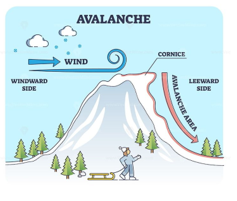Context:
The Indian Army’s Central Command has partnered with IIT-Kanpur signed a memorandum of understanding (MoU) to develop an Auto-Luminescent Avalanche Victim Detection System (AAVDS).
More on News:
- The MoU is signed to improve soldier safety in high-altitude and glaciated areas.
- The collaboration aims to leverage indigenous technological capabilities to develop a cutting-edge system for quick detection and accurate location of soldiers trapped under avalanche snow.
- The AAVDS will use a luminous liquid released from a compact, soldier-worn device to mark their position in the snow, significantly cutting down rescue time and boosting survival rates.
- Lieutenant General, Chief of Staff of Surya Command, emphasized that the initiative reflects the Indian Army’s commitment to self-reliance in defence technology, aiming to enhance troop effectiveness in challenging environments.
- The project lead from IIT Kanpur described it as a significant opportunity for indigenous research institutions to play a direct role in advancing the operational capabilities of the Indian Army.
- IIT Kanpur reaffirmed its commitment to leading future transformative initiatives aimed at strengthening national defence capabilities.
- The project will be overseen by an Ordnance Maintenance Company operating under the Central Command Headquarters, with Lt Col Piyush Dhariwal at the helm.
- The technology shows potential for civilian use, providing increased safety for mountaineers and adventure seekers in areas prone to avalanches beyond military applications.
About Avalaunch:

- An avalanche is a swift flow of snow down a slope or mountainside (NSIDC, 2021), triggered under suitable conditions on various inclines.
- They are most common and hazardous in specific regions during peak winter months, especially from December to April in the Northern Hemisphere (NSIDC, no date).
- Types of Avalanches:
- Loose Snow Avalanches: Begin at a single point and occur when poorly bonded snow detaches. Dry loose snow avalanches typically form on slopes of 40° or more, creating an inverted V-shape as particles roll and accumulate. These are slower and less dangerous due to their lower snow volume.
- Slab Avalanches: Involve the release of a cohesive snow layer (slab) over a snowpack with multiple layers. Usually occurring on slopes steeper than 30°, slab avalanches are larger and faster, reaching speeds of 50–100 km/h. A typical skier-triggered slab is about 50 m wide, 150–200 m long, and 50 cm thick.
- Gliding Avalanches: Release the entire snowpack along a broad fracture line, usually on smooth surfaces like rock or flattened grass. They can occur on slopes as shallow as 15°.
- Powder Avalanches: Often triggered by slab avalanches, these consist of airborne snow forming a fast-moving powder cloud. They can reach speeds of up to 300 km/h and cause severe destruction.
- Wet-Snow Avalanches: Triggered mainly by rising temperatures or rain, which weaken snowpack layers. Both loose and slab avalanches can contain wet snow and are typically naturally occurring.

